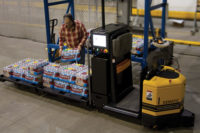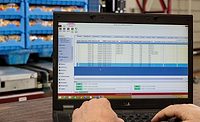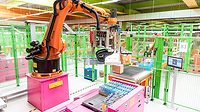![]()
Warehouse Technology: to Automate, or not to Automate
By the sheer nature of the
go-to-market strategy in many beverage
organizations, making a business case for automation in the warehouse has
been difficult. You will notice that I said in the warehouse. Automation
has existed for decades on the other side of the wall in manufacturing, and
today is rarely given a thought when new production or filling lines are
installed.
So why is it that most companies continue to
experience an increase in warehouse costs as a percentage of the cost of
goods sold, but still fail to consider automation in the warehouse? Do we
under-appreciate warehouses because of complexity? Maybe. Is it because
companies cannot justify automation because of their go-to-market
strategies that stress stem time to the first delivery point to many
facilities, thereby diluting shipping volume in any one facility? Probably.
Or, is it that because automation in the warehouse has received so little
attention, because few people understand it? Actually, the answer is all
three. At least it used to be.
To truly understand whether automation technology
makes sense for you, it is important to understand the different types of
technology.
Warehouse Management Technology
In the October 2003 issue, I discussed Warehouse
Management Technology (WMT). This subject is important to mention again for
several reasons. The most important is that WMT is a form of automation. It
automates the organization and dissemination of information within the
warehouse based on a set of rules the user defines. WMT manages three areas
really well: inventory, space and resources. The basis for inventory
control rests on your rules of inventory management that could include
first-in/first-out (FIFO), first-expiry/first-out (FEFO), or some other
approach. Managing space depends on a set of rules that define the type of
products that are suitable to store in specific storage locations. You
manage resources, including people and equipment, on the basis of their
capability, which is primarily driven by type of equipment; priority, which
is the next most important task; and proximity, who is physically
closest to perform the task. So in a conventional storage and handling
environment, WMT is considered automation.
Numerous WMT packages that offer varying levels of
capability for varying levels of cost are available in the marketplace.
There are WMT packages in which the person can tell the WMT where they put
product and the WMT keeps track, which is commonly referred to as a stock
locator system. There are others that tell all the people exactly what to
do and when to do it. I refer to this as task management.
Is WMT right for you? My professional opinion is
absolutely yes, with one caveat. No one solution fits every situation. It
is critical that you perform two tasks and perform them well. First, you
must optimize your warehouse process. Do not systematize poor processes.
Second, develop a thorough functional systems description (FSD) so you
understand what you are buying and so does the supplier.
Unit load handling and storage technology
When they think of automation, most people visualize
products moving without people or forklifts. Unfortunately, these mental
pictures often meet with a negative response as people have experienced poor attempts at
warehouse automation. I have been involved in several projects where my
role is to make existing automation serve the current business demands. My
comment in the previous paragraph about not systematizing poor practices
and doing a thorough FSD holds true here as well. Current and future
business demands as well as optimal work processes should be well thought
out as part of the automation planning process.
In beverage warehousing, there are two primary types
of automated material handling and storage technologies to consider: unit
load handling systems and case handling systems. Options for unit load
handling and storage systems are numerous and include automated guided
vehicles (AGVs) and automated storage and retrieval systems (AS/RS).
Today’s AGVs are vehicles programmed to drive to
designated points, taking designated paths, and perform designated tasks
requiring repetitive movements over extended distances. AGVs are typically
justified by eliminating congestion in warehouses where there are
repetitive trips taken over long distances.
You will find traditional AS/RS single-deep or
double-deep racks for storage within high-rise warehouses. Instead of
forklifts, unmanned vehicles, commonly referred to as stacker cranes,
travel up and down the aisle and into the rack structure to store and
retrieve product. AS/RS installations typically have small footprints with
aisles as narrow as 4 feet wide since forklifts do not travel through them.
Another type of AS/RS technology, offered by
Retrotech, is Activ. This is a high-density AS/RS for high-throughput,
high-turn unit load handling applications. Activ can move loads vertically
or horizontally on the X, Y and Z axis, and can continuously reprofile
inventory for upcoming waves of work. Most Activ users require only 30
percent of the space they would need in a conventional warehouse, saving
building costs. Also, as SKUs continue to grow, you can add additional
power drives to improve flexibility and throughput without adding
equipment.
Case handling technology
Individual case selection and mixed pallet building
have the distinction of traditionally being the most labor-intensive
activity in beverage warehouses. With such a wide variety of case sizes and
package types, traditional wisdom claims that automated case handling is
impossible. Only recently has technology (actually combinations of
technologies) allowed for successful automation implemented for case
handling. Individual cases can now be stored in towers and released
automatically onto conveyors in a pre-determined sequence based on customer
order requirements. You can now allow for the accumulation of individual
cases as they wait for entry into mixed-unit load palletizers.
Companies should never start with automation as an
improvement project but should finish with it as a way to improve
performance. Automation can deliver significant results with correct
application and support. BI
Ned Bauhof’s “beverage team” has
executed more than 100 projects in 85 locations in 10 countries. Ned is a
principal with York, Pa.-based St. Onge Co., a material handling and
logistics consulting firm specializing in the planning, engineering and
implementation of advanced material handling, information and control
systems supporting logistics, manufacturing and distribution since 1983
(www.stonge.com). Ned can be reached at 717/840-8181 or by email at
NedBauhof@stonge.com.



